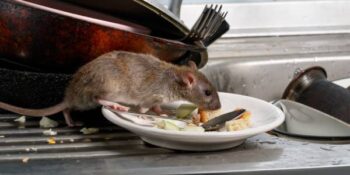
If you’ve found mice in your house, you’re not alone! Experts estimate that over 21 million homes are invaded by mice each year!
The house mouse is the most common mouse found on Long Island. House mice are small—only 2 inches long—and range from light brown to black in color.
Read on for 7 fun facts about this common household pest!
Fact #1: House Mice Poop…A Lot
One mouse can produce up to 100 droppings per day!
The average house mouse droppings are about 0.3 inches long and 0.12 inches wide. The length of the poop depends on how full it is with food, so you can expect less poop from a mouse that just ate its fill than you would expect from one that had just been fed a small amount.
House mice droppings are usually shaped like an upside-down teardrop with blunt edges on either end, but they can vary in shape depending on what the mice have eaten recently or if they have diarrhea.
Fact #2: House Mice Can Transmit Diseases to Humans 
Mice carry as many as 200 human disease-causing agents – pathogens including Hantavirus and Salmonella. Deer mice can introduce parasites like fleas, mites, and ticks into your home. Both mice contaminate food stored within your home and food prep areas with their urine and feces.
Fact #3: House Mice Eat Frequently
Mice eat between 15 and 20 times a day. House mice are omnivores, so they eat almost anything. They feed on plant material and animal matter, including seeds, grains, nuts, fruits, and vegetables; insects (eggs and larvae), birds’ eggs and adults, and food scraps left by humans.
Fact #4: House Mice Can Jump Surprisingly High
You can count on a house mouse to jump. House mice are able to jump up to 2 feet into the air (or more than 80 inches) and up to 1 foot across if they need it. They can also jump 6 inches in length, which is plenty of distance when it comes to getting around your home.
Fact #5: …And House Mice Can Even Do Tricks
Other mice tricks include are climbing and running up any rough vertical surface. The house mouse is also good at climbing down walls and across ceilings, just in case you have some sort of obstacle to overcome (which you probably won’t). They also can run along wires and cables. Mice can squeeze through openings slightly larger than 1/4 inch in width.
Fact #6: House Mice Don’t Live Very Long
The life span of a mouse is usually nine months to one year. Mice have the potential to live for longer, though they often don’t make it that long due to predation and disease.
Fact #7: House Mice Reproduce…A Lot
House mice have a tremendous capacity to reproduce. In a single year, a female may have five to ten litters of usually five or six young each. Young are born 19 to 21 days after mating and reach reproductive maturity in six to ten weeks.
How Can You Keep Mice Out of Your Home?
If you’re dealing with a rodent problem in your Long Island home, give Suburban Exterminating a call. Our team of exterminators is highly trained in identifying, removing, and preventing rodent problems in Long Island homes.
Call (631/516) 864-6900 today to get rid of the mice in your home.





